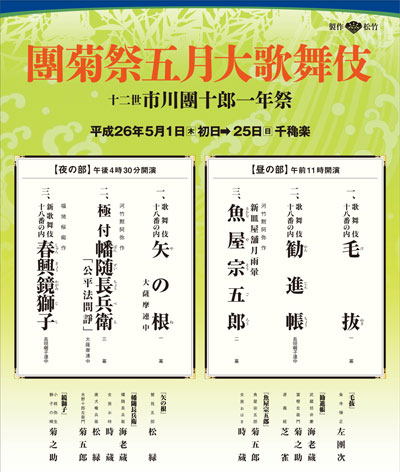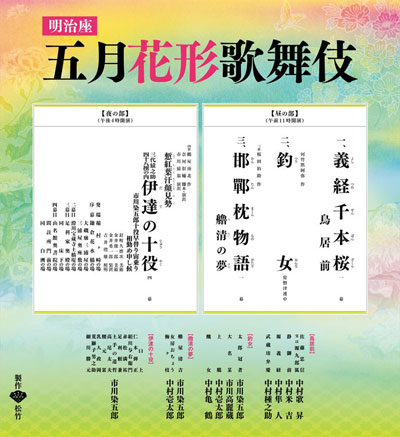| MAY 2014 |
|
5 shows in T˘ky˘ (Kabukiza, National Theatre, Meijiza), 1 shows in Ky˘to (Minamiza) and 1 tour (New Green Leaves)!!
|
| Kabukiza (T˘ky˘) |  |
| Dates | 1 ~ 25 May 2014 (Dankikusai Gogatsu ďkabuki) Dankikusai May Grand Kabuki |
| MatinÚe | |
| Evening | |
| Casting |
Onoe Kikugor˘, Ichikawa Ebiz˘, Onoe Kikunosuke, Nakamura Tokiz˘, Nakamura Shibajaku, Onoe Sh˘roku, Ichikawa Sadanji, Sawamura Tanosuke, Ichikawa Danz˘, Nakamura Kinnosuke, Band˘ Hikosabur˘, ďtani Tomoemon, Ichikawa Unosuke, Ichimura Kakitsu, Kawarasaki Gonjűr˘, Ichimura Manjir˘, Kataoka Ichiz˘, Band˘ Shűch˘, Band˘ Kamesabur˘, Band˘ Kametoshi, Kataoka Matsunosuke, Nakamura Matsue, Nakamura Baishi, Band˘ Minosuke, Nakamura Mantar˘, ďtani Hiromatsu, Onoe Ukon, Ichikawa Otora, Ichimura Kitsutar˘ |
| Comments |
The Dankikusai May Grand Kabuki performances is back at the Kabukiza after 5 years of absence (it was staged for the last time in May 2008). Due to the closing/opening ceremonies at the Kabukiza, the non-availability of this theater or the passing away of late Ichikawa Danjűr˘, it was either staged in ďsaka at the Sh˘chikuza (in May 2010 and May 2011) or not produced at all. It celebrates the first anniversary of the passing away of Ichikawa Danjűr˘ XII:
|
 |
| Meijiza (T˘ky˘) |  |
| Dates | 2 ~ 26 May 2014 (Gogatsu Hanagata Kabuki) May Young Actors Kabuki |
| MatinÚe |
Yoshitsune Senbon Zakura Kantan Makura Monogatari (Rosei no Yume) |
| Evening | |
| Casting |
Ichikawa Somegor˘, Nakamura Kash˘, Kataoka Hidetar˘, Nakamura Karoku, Band˘ Takesabur˘, Nakamura Kikaku, Ichikawa Komaz˘, Nakamura Kazutar˘, Nakamura Yonekichi, Nakamura Hayato, Nakamura Tanenosuke, Matsumoto Kingo, Sawamura S˘nosuke, ďtani Keiz˘, Nakamura Kotar˘, Nakamura Hayato, ďtani Hirotar˘, Nakamura Kichinosuke |
| Comments |
A Kabuki program at the Meijiza with Ichikawa Somegor˘ as zagashira: he plays for the first time the 10 roles of "Date no Jűyaku" [Somegor˘'s interview]:
|
 |
| National Theatre (T˘ky˘) |
| Dates | 10 ~ 21 May 2014 (Zenshinza Gogatsu K˘en) Zenshinza May Performances |
| Program | |
| Casting |
Kawarasaki Kunitar˘, Nakamura Umenosuke, Arashi Keishi, Fujikawa Yanosuke, Arashi Yoshisabur˘, Yamazaki Tatsusabur˘, Anegawa Shinnosuke, Matsunami Kihachir˘, Ikushima Kigor˘, Arashi Ichitar˘ |
| Comments |
The usual Zenshinza May program at the National Theatre! The Zenshinza tateonnagata Kawarasaki Kunitar˘ performs 7 roles in Tsuruya Nanboku IV's masterpiece "Osome no Nanayaku".
|
 |
|
|||
| Dates | 11 ~ 17 May 2014 (Kabuki Kansh˘ Ky˘shitsu) Kabuki Appreciation Class |
||
| Program | |||
| Casting | |||
| Comments |
22nd edition of a pedagogical show in Ky˘to combining explanation for beginners (done by the professional storyteller Katsura Kujaku) and two dance-dramas.
|
||
| New Green Leaves Tour | |
| Dates | 9 ~ 15 May 2014 (Shinroku Tokubetsu K˘en) New Green Leaves Special Performances |
| Program |
Miyako Fűryű Geidan Tsuki no Maki Kishű D˘j˘ji |
| Casting | |
| Comments |
A special and short tour led by the heirs of the Nakamuraya guild. The second item (geidan) in this program is a talk about art. All the others items are dances. |
|
|
| Contact | Main | Top | Updates | Actors | Plays | Playwrights | Programs | Links | FAQ | Glossary | Chronology | Illustrations | Prints | Characters | Derivatives | Theaters | Coming soon | News |